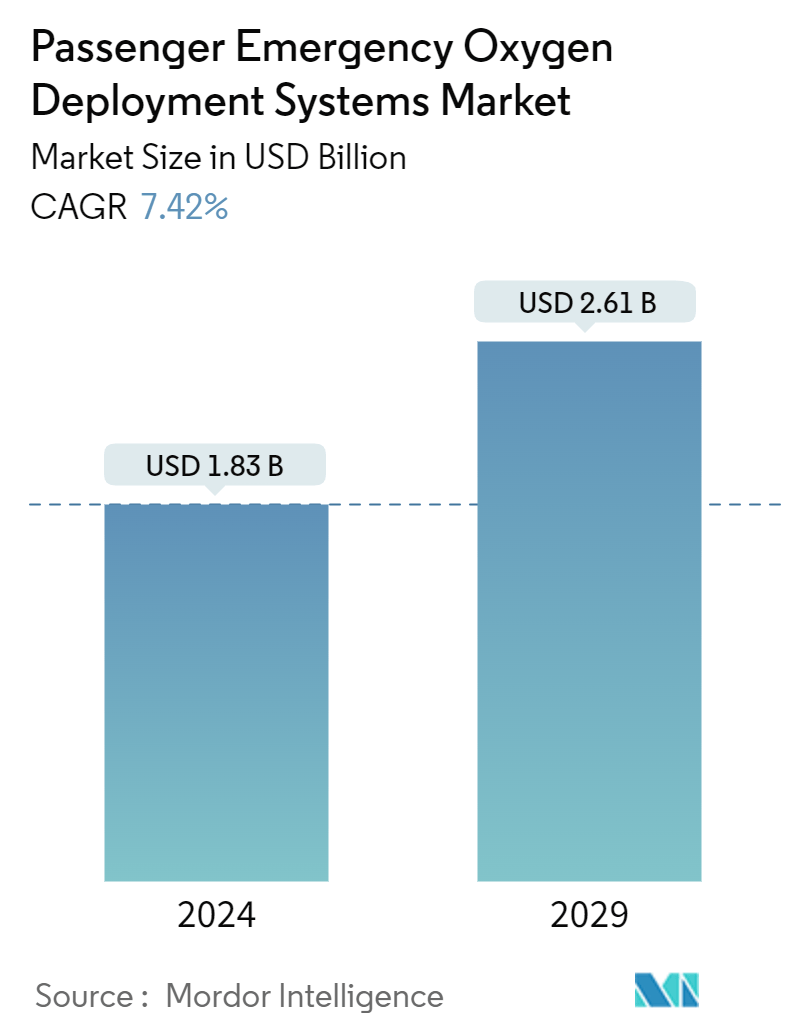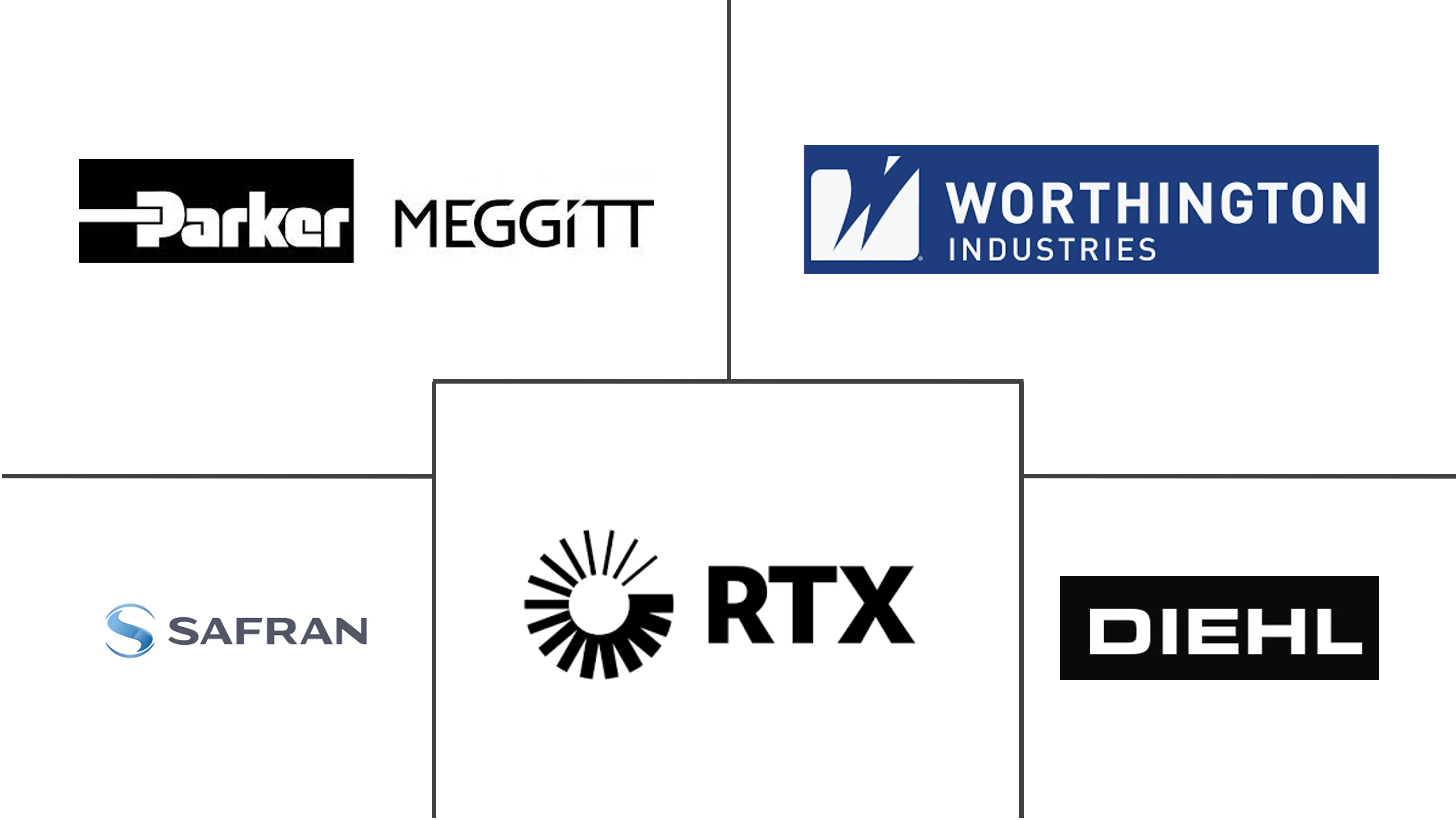
| Study Period | 2019 - 2029 |
| Market Size (2024) | USD 1.83 Billion |
| Market Size (2029) | USD 2.61 Billion |
| CAGR (2024 - 2029) | 7.42 % |
| Fastest Growing Market | Asia Pacific |
| Largest Market | North America |
| Market Concentration | High |
Major Players
*Disclaimer: Major Players sorted in no particular order |
Passenger Emergency Oxygen Deployment Systems Market Analysis
The Passenger Emergency Oxygen Deployment Systems Market size is estimated at USD 1.83 billion in 2024, and is expected to reach USD 2.61 billion by 2029, growing at a CAGR of 7.42% during the forecast period (2024-2029).
The International Air Transport Association (IATA) report shows that international air passenger traffic saw a significant uptick in 2023 compared to 2022, with a notable 36.9% surge. Specifically, the EU alone saw a 19% rise, carrying 976 million passengers in 2023.
The surge in orders and deliveries of new commercial aircraft, driven by the escalating passenger numbers, is set to boost the demand for emergency oxygen systems in aircraft. This demand is further bolstered by the retirement of older aircraft and stringent safety mandates. Additionally, cabin reconfigurations and system installations present lucrative opportunities for MRO players.
Heightened military spending in emerging economies is channeling investments into next-gen aircraft, bolstering their air capabilities. Given the high-G maneuvers that combat aircraft are designed for, pilots must wear oxygen masks to maintain consciousness. Consequently, the market anticipates a rise in the replacement of oxygen systems in the future.
Passenger Emergency Oxygen Deployment Systems Industry Segmentation
Emergency oxygen systems are deployed in the aircraft in case of emergencies to help passengers and crew. The market study includes all the components of aircraft oxygen systems, such as oxygen masks, oxygen storage devices, and oxygen delivery systems.
The passenger emergency oxygen deployment systems market is segmented by system, aircraft type, and geography. By system, the market is segmented into crew oxygen systems and passenger oxygen systems. By aircraft type, the market is segmented into commercial aircraft, general aviation aircraft, and military aircraft. Also, the report covers the market sizes and forecasts for the passenger emergency oxygen deployment systems market in major countries across various regions. For each segment, the market size is provided in terms of value (USD).
| Crew Oxygen System |
| Passenger Oxygen System |
| Commercial Aircraft |
| Military Aircraft |
| General Aviation Aircraft |
| North America | United States |
| Canada | |
| Europe | United Kingdom |
| Germany | |
| France | |
| Rest of Europe | |
| Asia-Pacific | China |
| India | |
| Japan | |
| South Korea | |
| Rest of Asia-Pacific | |
| Latin America | Brazil |
| Rest of Latin America | |
| Middle East and Africa | Saudi Arabia |
| United Arab Emirates | |
| Turkey | |
| Rest of Middle East and Africa |
Passenger Emergency Oxygen Deployment Systems Market Size Summary
The passenger emergency oxygen deployment systems market is poised for significant growth, driven by the increasing demand for new commercial aircraft and the need to replace aging fleets. This demand is further amplified by the rise in international air passenger traffic, which has seen a substantial increase, particularly in regions like the EU and Asia-Pacific. The market is also benefiting from the retirement of older aircraft and the implementation of stringent safety mandates, which necessitate the installation of advanced emergency oxygen systems. Additionally, the market is experiencing opportunities in cabin reconfigurations and system installations, particularly in the maintenance, repair, and overhaul (MRO) sector. The military sector's heightened spending on next-generation aircraft is also contributing to the market's expansion, as these aircraft require advanced oxygen systems for high-G maneuvers.
Key players in the market, such as Safran, RTX Corporation, Meggitt Ltd, Diehl Stiftung & Co. KG, and Worthington Industries Inc., are instrumental in supporting major commercial aircraft programs, including the A320, A330, A350 XWB, B737, and B787 Dreamliner. These companies are also expanding their offerings in general aviation aircraft programs. Strategic acquisitions and contracts, such as Safran's acquisition of Air Liquide Advanced Technologies' aeronautical oxygen and nitrogen activities, are enhancing their product lines. The Asia-Pacific region is expected to witness robust growth, with significant orders for narrowbody and widebody aircraft from countries like China, India, Japan, and South Korea, indicating a strong intent for fleet expansion and modernization.
Passenger Emergency Oxygen Deployment Systems Market Size - Table of Contents
1. MARKET DYNAMICS
- 1.1 Market Overview
- 1.2 Market Drivers
- 1.3 Market Restraints
-
1.4 Porter's Five Forces Analysis
- 1.4.1 Bargaining Power of Suppliers
- 1.4.2 Bargaining Power of Buyers/Consumers
- 1.4.3 Threat of New Entrants
- 1.4.4 Threat of Substitute Products
- 1.4.5 Intensity of Competitive Rivalry
2. MARKET SEGMENTATION
-
2.1 System
- 2.1.1 Crew Oxygen System
- 2.1.2 Passenger Oxygen System
-
2.2 Aircraft Type
- 2.2.1 Commercial Aircraft
- 2.2.2 Military Aircraft
- 2.2.3 General Aviation Aircraft
-
2.3 Geography
- 2.3.1 North America
- 2.3.1.1 United States
- 2.3.1.2 Canada
- 2.3.2 Europe
- 2.3.2.1 United Kingdom
- 2.3.2.2 Germany
- 2.3.2.3 France
- 2.3.2.4 Rest of Europe
- 2.3.3 Asia-Pacific
- 2.3.3.1 China
- 2.3.3.2 India
- 2.3.3.3 Japan
- 2.3.3.4 South Korea
- 2.3.3.5 Rest of Asia-Pacific
- 2.3.4 Latin America
- 2.3.4.1 Brazil
- 2.3.4.2 Rest of Latin America
- 2.3.5 Middle East and Africa
- 2.3.5.1 Saudi Arabia
- 2.3.5.2 United Arab Emirates
- 2.3.5.3 Turkey
- 2.3.5.4 Rest of Middle East and Africa
Passenger Emergency Oxygen Deployment Systems Market Research FAQs
How big is the Passenger Emergency Oxygen Deployment Systems Market?
The Passenger Emergency Oxygen Deployment Systems Market size is expected to reach USD 1.97 billion in 2025 and grow at a CAGR of 7.42% to reach USD 2.81 billion by 2030.
What is the current Passenger Emergency Oxygen Deployment Systems Market size?
In 2025, the Passenger Emergency Oxygen Deployment Systems Market size is expected to reach USD 1.97 billion.


